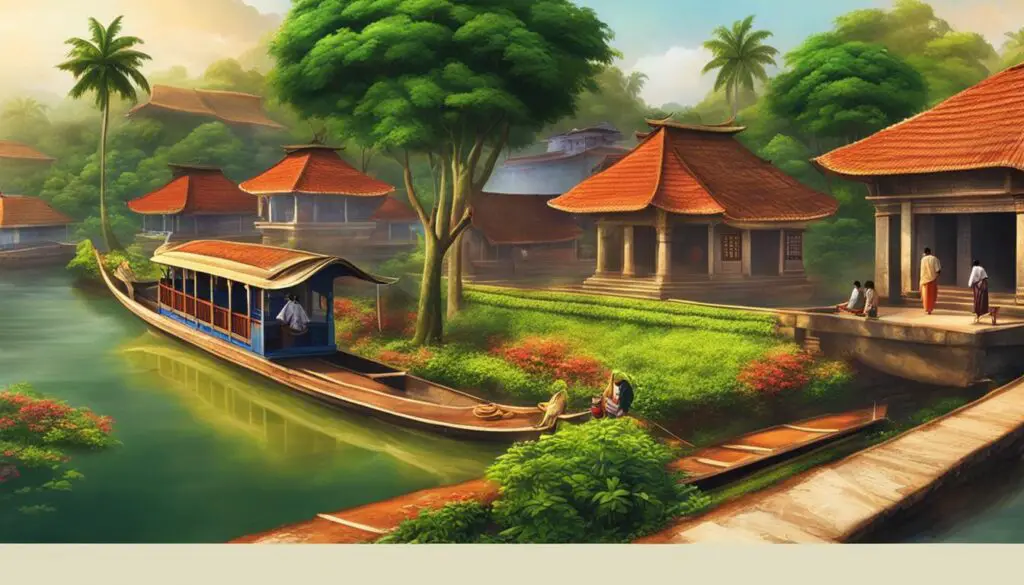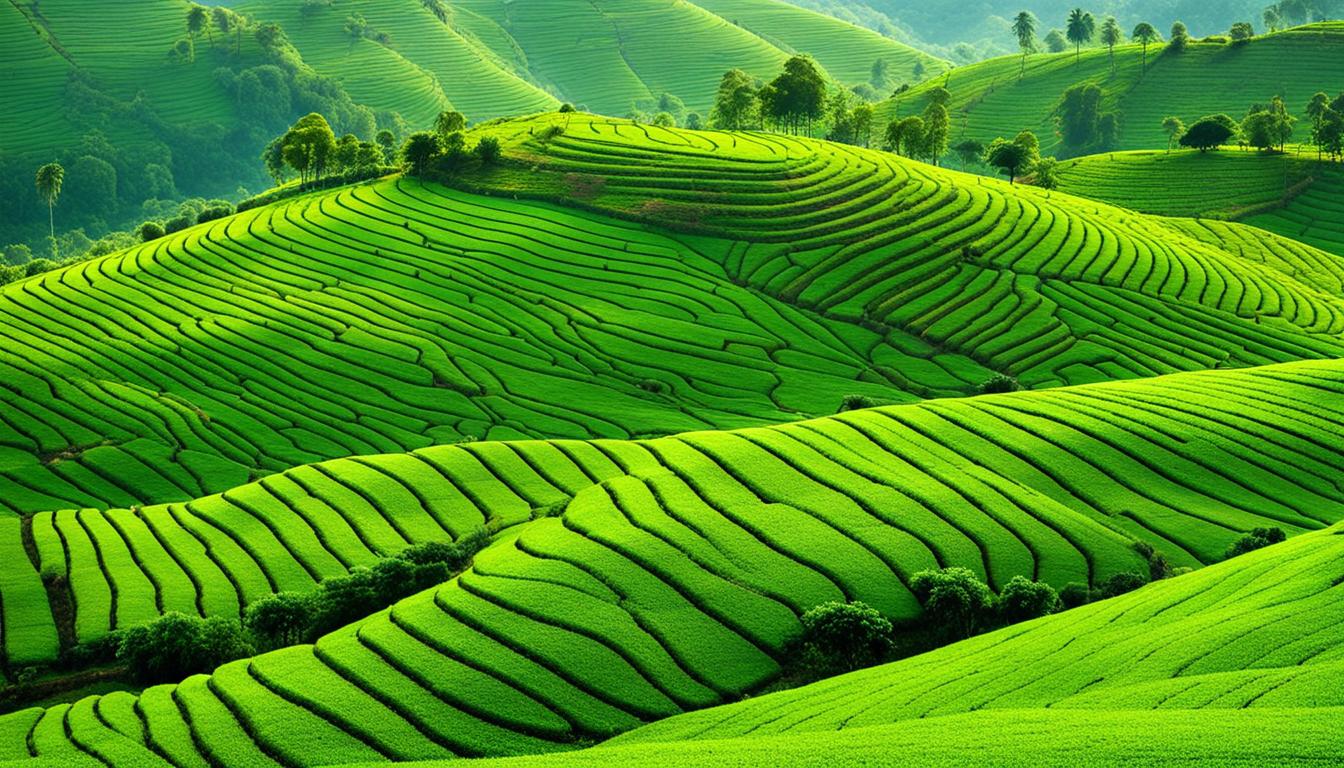Kerala, known as God’s Own Country, is a land of unparalleled beauty and diverse geography. From the pristine backwaters to the awe-inspiring Western Ghats, this Indian state offers a captivating blend of natural wonders.
The geography of Kerala can be divided into three distinct regions: the High Land, Mid Land, and Coastal Region. The High Land is dominated by the magnificent Western Ghats, a mountain range that stretches across the state. With peaks reaching heights of up to 2700 meters above sea level, the Western Ghats offer breathtaking views and are a paradise for nature lovers and adventure enthusiasts alike.
The Mid Land of Kerala is characterized by lush paddy fields that have been the backbone of the state’s agricultural economy for centuries. However, the preservation of agricultural land faces challenges due to the Wetland Paddy Land Act and the encroachment of urbanization. Balancing development and the preservation of these fertile lands is crucial to sustain Kerala’s agrarian heritage.
The Coastal Region of Kerala is renowned for its intricate network of canals and rivers, which form the iconic backwaters. This unique ecosystem not only supports the local economy but also attracts tourists from around the world. The backwaters provide an opportunity for visitors to experience the tranquility of Kerala’s waterways and immerse themselves in the rich culture and heritage of the region.
Key Takeaways:
- Kerala’s diverse geography encompasses the Western Ghats, backwaters, and fertile paddy fields.
- The Western Ghats offer stunning mountain views and opportunities for adventure.
- Kerala’s paddy fields face challenges due to urbanization and the Wetland Paddy Land Act.
- The backwaters of Kerala are a unique ecosystem and a major tourist attraction.
Challenges and Opportunities in Real Estate Development
When it comes to real estate development in Kerala, there are both challenges and opportunities that developers face. One of the main challenges is the limited availability of space. With the increasing population and growing demand for housing, finding suitable land for construction is becoming a critical issue.
In Kerala, the areas around the Western Ghats are strictly off-limits for construction due to environmental regulations. These regulations aim to protect the rich biodiversity and fragile ecosystems of this region. While these regulations are necessary for the preservation of nature, they pose a challenge for real estate developers who are looking to expand their projects.
On the other hand, the Mid Land, traditionally a hub for development, is facing its own set of challenges. The shrinking of agricultural land and the need to balance development with preserving paddy fields have become significant concerns. Developers must navigate through these challenges to ensure sustainable growth while respecting the cultural and agricultural heritage of the region.
In the face of these obstacles, developers are exploring alternative construction methods to make the most of limited space. High-rise buildings are being considered to accommodate more families without consuming a large footprint. By going vertical, developers can create additional living spaces while providing modern amenities and facilities.
However, real estate development in Kerala is subject to various regulations, including the Floor Area Ratio (F.A.R) limits. These restrictions dictate the maximum permissible built-up area for a given plot of land based on its size. Additionally, coastal construction regulations limit the height and type of structures that can be built along the coast, further impacting the opportunities for development.
“Real estate development in Kerala is a delicate balance between meeting the growing demand for housing and preserving the state’s natural beauty and resources. It requires a proactive approach from developers, government bodies, and environmentalists to find sustainable solutions,” says Rajendra Kumar, a renowned architect in Kerala.
Despite these challenges, the real estate sector in Kerala also presents significant opportunities. The growing demand for housing, coupled with the need for modern facilities and infrastructure, creates a favorable environment for developers. In addition to high-rise buildings, villa projects that offer luxury and comfort are also gaining popularity among homebuyers.
To seize these opportunities and overcome the challenges, developers must adopt sustainable practices, make proactive amendments to regulations, and collaborate closely with government bodies and environmental experts. By striking a balance between development and conservation, Kerala can achieve growth that respects its unique geography and preserves its natural treasures.
Balancing Development and Environmental Conservation
The limited availability of space in Kerala requires us to adopt responsible and innovative approaches to construction and development. Instead of aspiring for independent villas and expansive bungalows, it is crucial to focus on maximizing space utilization while minimizing the negative impact on nature. By promoting vertical construction, we can provide sustainable housing solutions for families in a smaller footprint, preserving valuable land and resources.
Promoting Space Utilization through Vertical Construction
To address the space constraints in Kerala, vertical high-rise constructions offer a practical solution. By constructing upwards, we can optimize land use and accommodate more families within a smaller area. This not only helps in resolving the issue of limited space but also contributes to creating vibrant urban areas that maximize the potential of available land. The utilization of vertical space allows for a more sustainable and efficient use of resources.

Government Collaboration and Regulatory Amendments
Striking a balance between development and environmental conservation calls for collaborative efforts between the government and relevant authorities. Amendments to regulations like the Floor Area Ratio (F.A.R) and coastal construction limits are essential to encourage vertical construction and save space. By adapting these regulations to align with the evolving needs of sustainable development, we can unlock the potential for growth while preserving the natural beauty of Kerala.
Vertical construction offers a promising solution to the space limitations Kerala faces. Through collaborative efforts and regulatory amendments, we can pave the way for a sustainable and responsible approach to real estate development.
Proactive Measures for Environmental Sustainability
In addition to vertical construction and regulatory changes, proactive measures must be implemented to control and minimize the effects of natural disasters such as floods and rising sea levels. Investing in sustainable drainage systems, flood prevention mechanisms, and eco-friendly construction methods can help mitigate the environmental impact of development activities. These measures ensure the preservation of nature and safeguard the well-being of communities in the face of climate change.
Striving for Sustainable Growth
By finding the right balance between development and environmental conservation, we can achieve sustainable growth in Kerala’s housing sector. Responsible space utilization, vertical construction, and proactive measures for environmental sustainability are key to ensuring a harmonious coexistence between modern infrastructure and the preservation of nature. Together, we can shape a future where development and conservation go hand in hand, creating a better and greener Kerala for generations to come.
Conclusion
In conclusion, Kerala’s diverse geography, including the stunning Western Ghats and the serene backwaters, offers a unique backdrop for real estate development. However, the limited availability of space and stringent environmental regulations present significant challenges to construction and development in the state.
To overcome these challenges, innovative solutions such as high-rise buildings can be explored to maximize space utilization. It is essential to strike a balance between development and environmental conservation to ensure the sustainable growth of Kerala’s housing sector.
Responsible choices in construction practices, such as vertical constructions, can help meet the growing demands of the housing sector while respecting the natural beauty of the state. Moreover, proactive measures must be taken to safeguard against natural disasters and rising sea levels, preserving the integrity of the region.
By embracing sustainable development practices and preserving the diverse geography of Kerala, we can create a bright future that harmoniously combines growth and conservation. It is crucial for all stakeholders to work together towards a shared vision of responsible and balanced real estate development in God’s Own Country.
FAQ
What is the geography of Kerala like?
Kerala is known as the God’s Own Country and has a diverse geography. It can be divided into three main regions: the High Land, Mid Land, and Coastal Region. The High Land is dominated by the majestic Western Ghats, while the Mid Land consists of fertile paddy fields. The Coastal Region is characterized by a network of canals and rivers, creating the famous backwaters.
What are the main challenges in real estate development in Kerala?
The limited availability of space is one of the main challenges in real estate development in Kerala. Construction is strictly prohibited in environmentally sensitive areas like the Western Ghats. The shrinking of agricultural land in the Mid Land region and regulations like the Wetland Paddy Land Act also pose challenges to development. Coastal construction restrictions and regulations like the Floor Area Ratio (F.A.R) further hinder real estate development in the state.
How can space limitations be addressed in real estate development in Kerala?
Alternative construction methods such as high-rise buildings can be considered to maximize space utilization in Kerala. Instead of aspiring for independent villas and expansive bungalows, vertical constructions can provide housing solutions for families in a smaller footprint. Amendments to regulations like F.A.R and coastal construction limits can promote vertical construction and save space.
How can development and environmental conservation be balanced in Kerala?
Responsible choices should be made while utilizing space for construction in order to preserve the natural beauty of Kerala. Proactive measures should be implemented to control and minimize the effects of natural disasters like floods and rising sea levels. The government and relevant authorities need to work together to find a balance between development and environmental conservation, ensuring the sustainable growth of Kerala’s housing sector.
